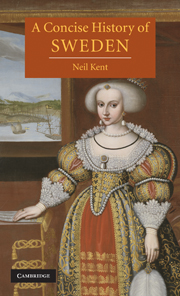Book contents
- Frontmatter
- Contents
- List of illustrations
- Maps
- Preface
- 1 From prehistory to Viking hegemony
- 2 The formation and growth of the Swedish state
- 3 The territorial consolidation of Sweden
- 4 Towards a centralist and military state
- 5 The collapse of absolutism and the Age of Freedom
- 6 Royal absolutism restored
- 7 Constitutional Sweden
- 8 The industrialisation and capitalisation of Sweden
- 9 The world wars and Swedish neutrality
- 10 Triumph of the Swedish welfare state
- Conclusion
- Appendix 1 Chronology
- Appendix 2 Monarchs and regents of Sweden
- Appendix 3 Prime ministers
- Selected further reading
- Index
10 - Triumph of the Swedish welfare state
Published online by Cambridge University Press: 05 June 2014
- Frontmatter
- Contents
- List of illustrations
- Maps
- Preface
- 1 From prehistory to Viking hegemony
- 2 The formation and growth of the Swedish state
- 3 The territorial consolidation of Sweden
- 4 Towards a centralist and military state
- 5 The collapse of absolutism and the Age of Freedom
- 6 Royal absolutism restored
- 7 Constitutional Sweden
- 8 The industrialisation and capitalisation of Sweden
- 9 The world wars and Swedish neutrality
- 10 Triumph of the Swedish welfare state
- Conclusion
- Appendix 1 Chronology
- Appendix 2 Monarchs and regents of Sweden
- Appendix 3 Prime ministers
- Selected further reading
- Index
Summary
THE AFTERMATH OF THE SECOND WORLD WAR
At the conclusion of the Second World War, from which Sweden had emerged largely unscathed, the country enjoyed greater social cohesion than ever before. With its social welfare infrastructure now firmly established, its benefits now came to be widely extended throughout its relatively homogeneous society, in which the overwhelming majority of citizens shared common ethnic, cultural and religious values, much as they had done for centuries. Immigration was limited largely to refugees who had escaped religious or political persecution, whether from Nazi Germany and the Soviet Union, or after the war from the Soviet-occupied states of eastern Europe, in particular from Poland, Estonia and Hungary. Later, they came to help carry out much of the work needed for the physical extension of the welfare state into which Sweden was being moulded, but in the immediate post-war years, their settlement – or removal – was a major problem. Deciding who could or could not remain permanently in Sweden was an especially thorny issue, often with life and death implications for the refugees.
More than 30,000 refugees from the Baltic states, now occupied by the Soviet Union, were allowed to remain. On the other hand, 2,700 German soldiers, with another 145 Latvians, Lithuanians and Estonians who had fought alongside the Germans but later taken flight to Sweden, were expatriated eastwards, either to prison camps or certain death. In these cases, Swedish fears of inflaming Russia, were they to permit the latter’s former enemy combatants a lasting refuge, had proved too great to overcome. Many of these refugees to Sweden, therefore, ended their lives in the Soviet labour camps to which they were ultimately sent.
- Type
- Chapter
- Information
- A Concise History of Sweden , pp. 238 - 263Publisher: Cambridge University PressPrint publication year: 2008



